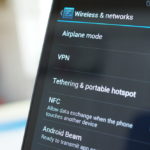 If you’re reading this, you’re lucky enough not to live in one of the 100,000-plus homes across Virginia, Delaware, New Jersey, and other states that, as of about 2:45 p.m. Monday, have already lost power due to Hurricane Sandy. You already have a disaster plan for your food and your pets in case of a power outage, but what about your Internet? If your access is down, you won’t be able to live-tweet the hurricane and upload crazy flooding photos!
If you’re reading this, you’re lucky enough not to live in one of the 100,000-plus homes across Virginia, Delaware, New Jersey, and other states that, as of about 2:45 p.m. Monday, have already lost power due to Hurricane Sandy. You already have a disaster plan for your food and your pets in case of a power outage, but what about your Internet? If your access is down, you won’t be able to live-tweet the hurricane and upload crazy flooding photos!
The solution: to use your smartphone as a wi-fi hotspot for your laptop, game console, or other devices.
If you have a Droid:
Install an app like Extended Control, Wi-Fi Tether, Wireless Tether for Root Users, or Foxfi. According to Computer World’s J.R. Raphael, Wi-fi hotspot functionality is ingrained into Android devices. The problem usually arises when it comes to your carrier. Many carriers, such as Verizon, require you to pay to use the Wi-Fi hotspot as an additional feature.
However, says Raphael:
Just between you and me, as long as you don’t suddenly start burning through copious amounts of data, the odds of anyone noticing are probably pretty low. People (erm, no one in particular, of course) have been doing this for a long time without any problems. Still, you should read through your carrier’s usage agreement and make sure you understand its policies before deciding if you want to proceed. Like with all non-officially-endorsed procedures, this is an adventure you’ll have to embark on at your own risk.
If you have an iPhone:
If you have a data-sharing plan such as AT&T’s Mobile Share plan or Verizon’s Share Everything plan, a personal hot-spot option is included. You can call your carrier and enable your iPhone’s hotspot capability now, but AT&T customers with an unlimited data plan be warned that opting into the company’s hotspot features will downgrade your current plan to a more limited version. Gadget Review walks you through the range of corporate-sponsored hotspot features for the iPhone. Alternatively, you can install the app iTether on both your phone and computer. iTether’s plan costs $30 per year, but may set you back significantly less than enabling the hot-spot from your carrier.
A word of caution: All of this will drain your phone battery, and if your own Internet is down, odds are your electricity is not that far behind. Maybe save the Homeland episodes for once the power is back on.
Article appeared in Slate Magazine By Amrita Khalid
